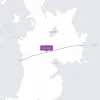BDUK Issue First 2025 Update on UK Project Gigabit Broadband Progress

The Government’s (DSIT) Building Digital UK agency has today published their first 2025 progress report on the £5bn Project Gigabit broadband rollout scheme, which covers the April to December 2024 period. The data reveals that some 1,188,400 UK premises have received gigabit-capable broadband coverage by BDUK’s gigabit programmes since their inception.
At present around 88% of UK premises can already access a gigabit-capable network (here) and Ofcom separately forecasts that this could hit around 97% by May 2027 (here). Most of this has been delivered by commercial deployments (predominantly focused on urban and semi-urban areas), but there are some areas in the final 10-20% of premises that are simply too expensive for commercial providers to tackle.
Project Gigabit itself was originally established in 2021 to help extend broadband ISP networks capable of delivering download speeds of at least 1000Mbps (1Gbps), and uploads of at least 200Mbps, to achieve “nationwide” coverage (c.99%) by 2030 2032 (here) – focusing on the commercially unviable areas (usually rural and semi-rural locations). The project has already committed most of its budget up to 2030, but there are still some contracts yet to be awarded and others that have failed or been scaled-back (here, here and here).
Advertisement
The project primarily consists of several support schemes, including the Gigabit Broadband Voucher Scheme (£210m), funding to extend Dark Fibre around the public sector (£110m) and gap-funded deployments with suppliers (mostly the rest of funding) – known as the Gigabit Infrastructure Subsidy (GIS) programme.
However, the progress reports on this scheme have, over the past year or so, become gradually less and less detailed (they also used to be published on a quarterly basis). The latest one follows this trend, but we do get a fair bit of detail in the spreadsheet, even if there seem to be no updates on Project Gigabit’s future contract pipeline.
What’s New in the July 2025 Update
Overall, BDUK sestimate that their interventions delivered 113,700 premises with gigabit-capable broadband coverage between 1st April 2024 and 31st December 2024. In total this means that a cumulative estimate of 1,188,400 premises have received gigabit-capable coverage via BDUK’s gigabit programmes since their inception.
Of the premises delivered by BDUK between 1 April 2024 and 31 December 2024:
Advertisement
- 38% (43,400) were delivered under the Government Infrastructure Subsidy scheme (GIS, Gigabit contracts)
- 38% (42,900) were delivered by Vouchers (gigabit broadband voucher scheme)
- 24% (27,500) were delivered by “Superfast & Hubs”
Take note that BDUK count both directly subsidised premises as well as uncommercial premises that were not directly funded but received connections as a result of nearby BDUK funded projects. “As a result, all premises passed figures are estimates based on a combination of raw supplier data and modelled estimates,” said BDUK.
The spreadsheets also include some additional data and a regional breakdown of the figures, as well as by each contract, which we’ve included below. One key thing to note below is that Project Gigabit itself has still only delivered a relatively small amount of gigabit coverage, with the earlier ‘Superfast Broadband Programme‘ (SFBB) still holding the lion’s share.
BDUK – Gigabit Premises Passed by Year, Country and Region
| Country/Region ONS code | Country/Region | Total to 31 December 2024 |
| E92000001 | England | 829,400 |
| E12000001 | North East | 31,100 |
| E12000002 | North West | 61,800 |
| E12000003 | Yorkshire and The Humber | 82,100 |
| E12000004 | East Midlands | 86,800 |
| E12000005 | West Midlands | 85,000 |
| E12000006 | East of England | 155,900 |
| E12000007 | London | 9,200 |
| E12000008 | South East | 157,700 |
| E12000009 | South West | 159,800 |
| N92000002 | Northern Ireland | 126,600 |
| S92000003 | Scotland | 112,200 |
| W92000004 | Wales | 120,100 |
| K02000001 | United Kingdom | 1,188,400 |
Premises Passed by Year and BDUK Intervention Type
Advertisement
| BDUK intervention | Total to 31 December 2024 |
| GIS (Gigabit contracts) | 54,300 |
| Hubs | 5,700 |
| Superfast | 787,600 |
| Vouchers | 340,800 |
| of which counted premises | 226,600 |
| of which calculated using a multiplier | 114,200 |
| Total | 1,188,400 |
| Vouchers connected | 139,000 |
Premises Contracted and Passed by GIS Contracts (Progress to Dec 2024)
| Lot area name | Supplier | Total number of contracted premises built to 31 December 2024 |
| Buckinghamshire, Hertfordshire and East of Berkshire | CityFibre | 170 |
| Cambridgeshire and adjacent areas | CityFibre | 4,990 |
| Mid Cornwall | Wildanet | 3,580 |
| Cumbria | Fibrus | 8,440 |
| Dorset and South Somerset | Wessex Internet | 50 |
| Durham Teesdale | GoFibre | 3,570 |
| Hampshire | CityFibre | 1,930 |
| Leicestershire and Warwickshire | CityFibre | 1,000 |
| Lincolnshire and East Riding | Quickline | 610 |
| New Forest | Wessex Internet | 4,240 |
| Norfolk | CityFibre | 4,990 |
| North Dorset | Wessex Internet | 4,800 |
| North Shropshire | Freedom Fibre | 970 |
| North Yorkshire | Quickline | 50 |
| North Northumberland | GoFibre | 3,040 |
| South West Cornwall | Wildanet | 3,860 |
| South Wiltshire | Wessex Internet | 810 |
| South Yorkshire | Quickline | 2,770 |
| Suffolk | CityFibre | 7,210 |
| West and parts of North Yorkshire | Quickline | 4,950 |
| Total | 62,030 |
Project Gigabit / BDUK Delivery Performance
https://www.gov.uk/government/statistics/bduk-delivery-performance-quarterly-april-2024-to-december-2024
Mark is a professional technology writer, IT consultant and computer engineer from Dorset (England), he also founded ISPreview in 1999 and enjoys analysing the latest telecoms and broadband developments. Find me on X (Twitter), Mastodon, Facebook, BlueSky, Threads.net and Linkedin.
« O2 UK and Ontix Expand 4G Mobile Small Cells to Bristol’s Clifton Area
Advertisement
Leave a Reply Cancel reply
Privacy Notice: Please note that news comments are anonymous, which means that we do NOT require you to enter any real personal details to post a message and display names can be almost anything you like (provided they do not contain offensive language or impersonate a real person�s legal name). By clicking to submit a post you agree to storing your entries for comment content, display name, IP and email in our database, for as long as the post remains live.
Only the submitted name and comment will be displayed in public, while the rest will be kept private (we will never share this outside of ISPreview, regardless of whether the data is real or fake). This comment system uses submitted IP, email and website address data to spot abuse and spammers. All data is transferred via an encrypted (https secure) session.





















































Would be nice to see the Openreach Type C data when it becomes available, unless it’s counted as commercially sensitive?
Openreach only got the first Type C contracts in late August 24, so only a few months before the cut off on this report.
It’s safe to assume it won’t be sensitive and will be highlighted in next years report no doubt. If the report had run to march 2025 there would have been data.
The summary report interestingly doesn’t show even though there is some gigabit funding from bduk, the Scotland r100 build which totalled 27k via Openreach last year / all gigabit coverage covering period April 24 to March 25. Would have boosted the 62k overall significantly .
Looks like the usual BDUK maths here, 54,300 GIS delivered in one table and then a breakdown that suggests 62,030 premises delivered by GIS in the same period.
There’s also no mention of how many of those GIS delivered were commercial premises their GIS contracts have overbuilt, due to their insanely slow descope processes. It says a lot that the superfast delivery (which isn’t exclusively FTTC) and vouchers both exceeded the GIS delivery in the same period.